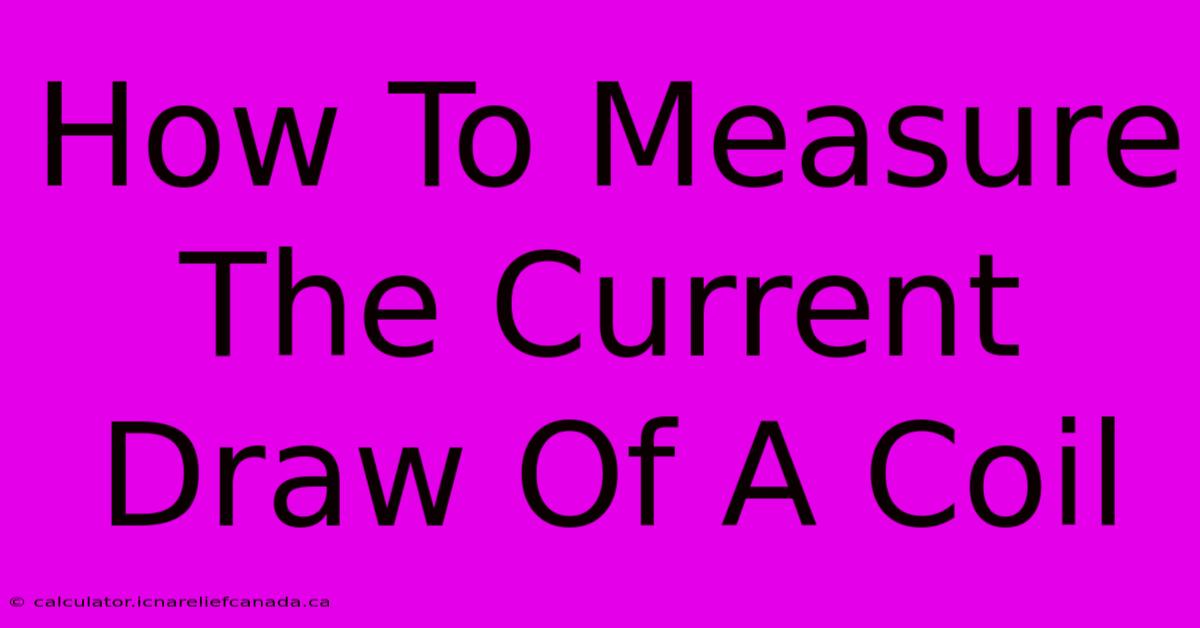How To Measure The Current Draw Of A Coil

Table of Contents
How To Measure the Current Draw of a Coil
Measuring the current draw of a coil is crucial for various applications, from verifying its operational parameters to troubleshooting electrical circuits. This process involves understanding the coil's properties and employing appropriate measurement techniques. This article will guide you through several methods, ensuring accuracy and safety.
Understanding Coil Current Draw
Before we delve into the measurement process, it's important to understand what factors influence a coil's current draw. The primary factors are:
- Voltage: The applied voltage directly impacts the current flowing through the coil. Higher voltage generally results in higher current, assuming other factors remain constant.
- Resistance: A coil's resistance (often referred to as DC resistance or DCR) dictates how much it opposes the flow of current. Higher resistance leads to lower current. This resistance is inherent to the coil's wire material, length, and gauge.
- Inductance: Inductance is a coil's property to oppose changes in current. While it doesn't directly affect DC current (steady-state), it significantly impacts AC current, causing a phase shift and potentially reducing the current flow.
- Frequency (for AC): If you're measuring AC current, the frequency plays a vital role. Higher frequencies can significantly reduce the current due to the coil's inductive reactance.
Methods for Measuring Coil Current Draw
There are several ways to measure the current draw of a coil, each suited to different circumstances and levels of precision.
1. Using a Multimeter: The Direct Approach
This is the simplest method, suitable for measuring the DC current draw of a coil.
Materials:
- Multimeter: A multimeter capable of measuring current (amps) is essential. Ensure it's appropriately rated for the expected current level.
- Test Leads: Use appropriate test leads compatible with your multimeter.
Procedure:
- Set the Multimeter: Set your multimeter to measure DC current (A). Select the appropriate range; start with a higher range and gradually decrease it until you get a stable reading. Always start with a higher range to avoid damaging your multimeter.
- Connect in Series: Break the circuit supplying power to the coil. Connect the multimeter in series with the coil. This means connecting one lead to one side of the coil and the other lead to the power supply. The current will flow through the multimeter.
- Apply Power: Apply power to the circuit and observe the reading on the multimeter. This reading represents the coil's DC current draw.
- Safety First: Always ensure that the power supply is turned off before connecting or disconnecting the multimeter.
2. Using a Clamp Meter: Non-Invasive Measurement
A clamp meter provides a non-invasive way to measure current, ideal for situations where breaking the circuit is inconvenient or impossible.
Materials:
- Clamp Meter: A clamp meter capable of measuring AC or DC current, depending on your needs.
Procedure:
- Select the Range: Set the clamp meter to the appropriate current range.
- Clamp Around the Wire: Clamp the meter's jaws around the wire supplying current to the coil. Ensure the wire passes through the jaws only once.
- Take the Reading: The clamp meter will directly display the current flowing through the wire.
3. Advanced Techniques for AC Current and Impedance Measurement
Measuring AC current requires considering the coil's impedance (a combination of resistance and reactance). This often necessitates more sophisticated equipment:
- Oscilloscope and Current Probe: An oscilloscope with a current probe provides a visual representation of the current waveform, allowing for analysis of both magnitude and phase.
- Impedance Analyzer: This specialized instrument directly measures the coil's impedance at various frequencies.
These methods are more complex and require a deeper understanding of electrical engineering principles.
Safety Precautions
- Always turn off the power supply before connecting or disconnecting any measurement equipment.
- Choose the appropriate current range on your multimeter to avoid damaging the meter.
- Be mindful of the voltage and current levels involved. High voltages and currents can be dangerous.
- If you are unsure about any aspect of the measurement process, seek assistance from a qualified electrician.
By understanding the factors affecting coil current draw and employing the appropriate measurement techniques, you can accurately determine the current flowing through your coil, ensuring efficient operation and troubleshooting of electrical circuits. Remember to always prioritize safety during the measurement process.

Thank you for visiting our website wich cover about How To Measure The Current Draw Of A Coil. We hope the information provided has been useful to you. Feel free to contact us if you have any questions or need further assistance. See you next time and dont miss to bookmark.
Featured Posts
-
Maple Leafs Practice Matthews Focus
Feb 08, 2025
-
How To Make A Plactice Botle Car Fly
Feb 08, 2025
-
How To Build A Barn Door
Feb 08, 2025
-
How To Unlock Inspect Tool 2024
Feb 08, 2025
-
Omni Adventure How To Recalibrate
Feb 08, 2025
